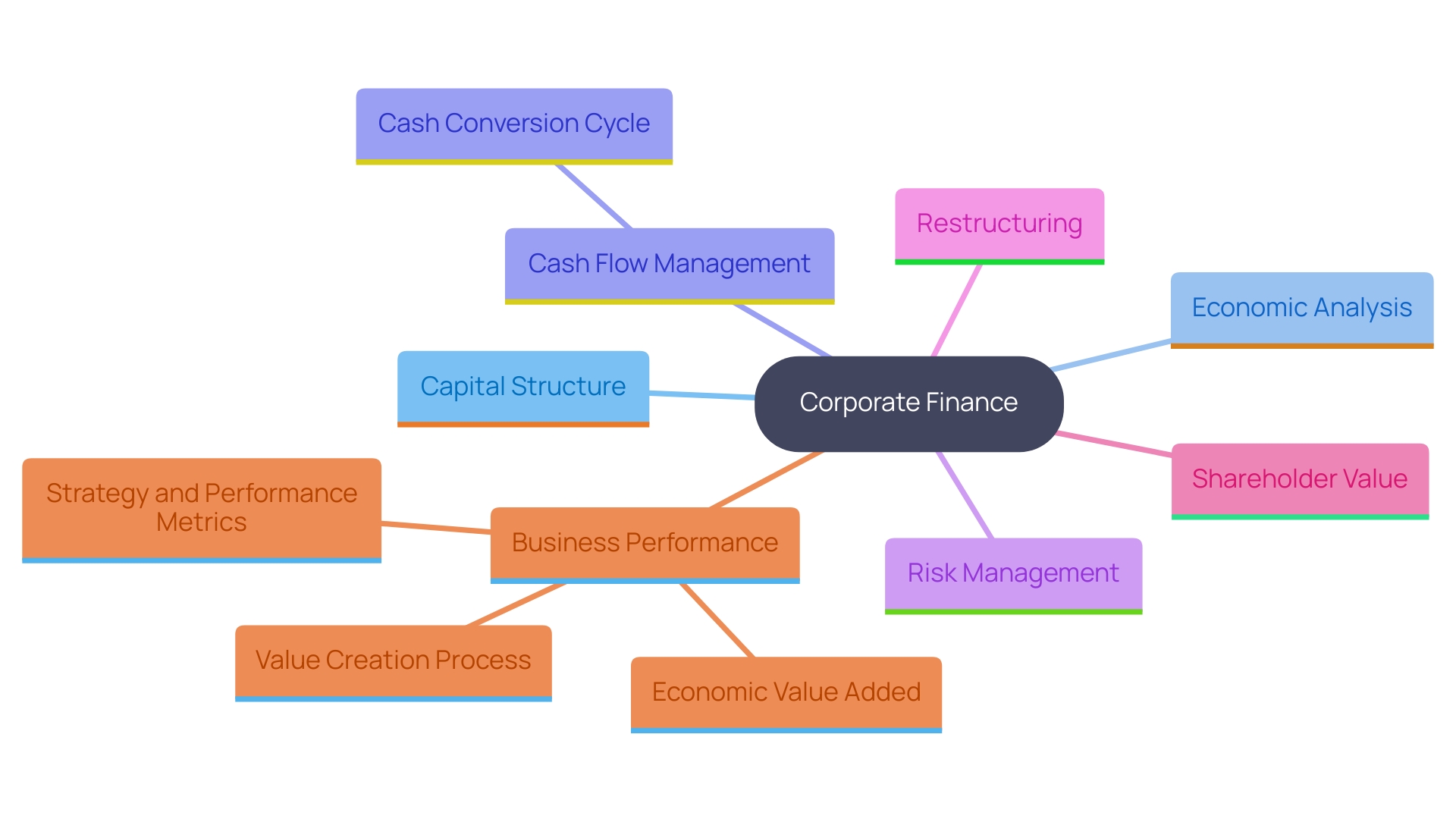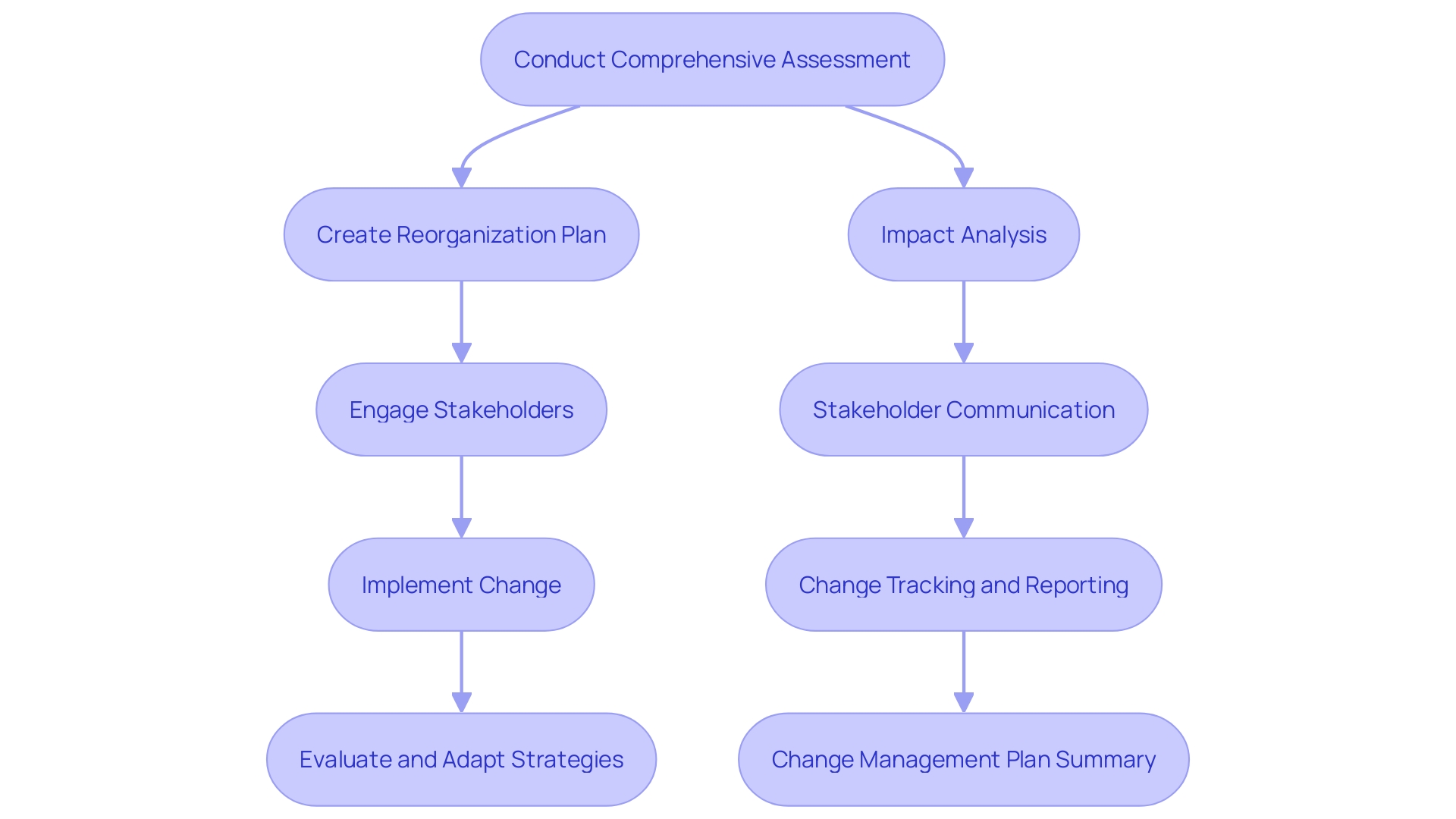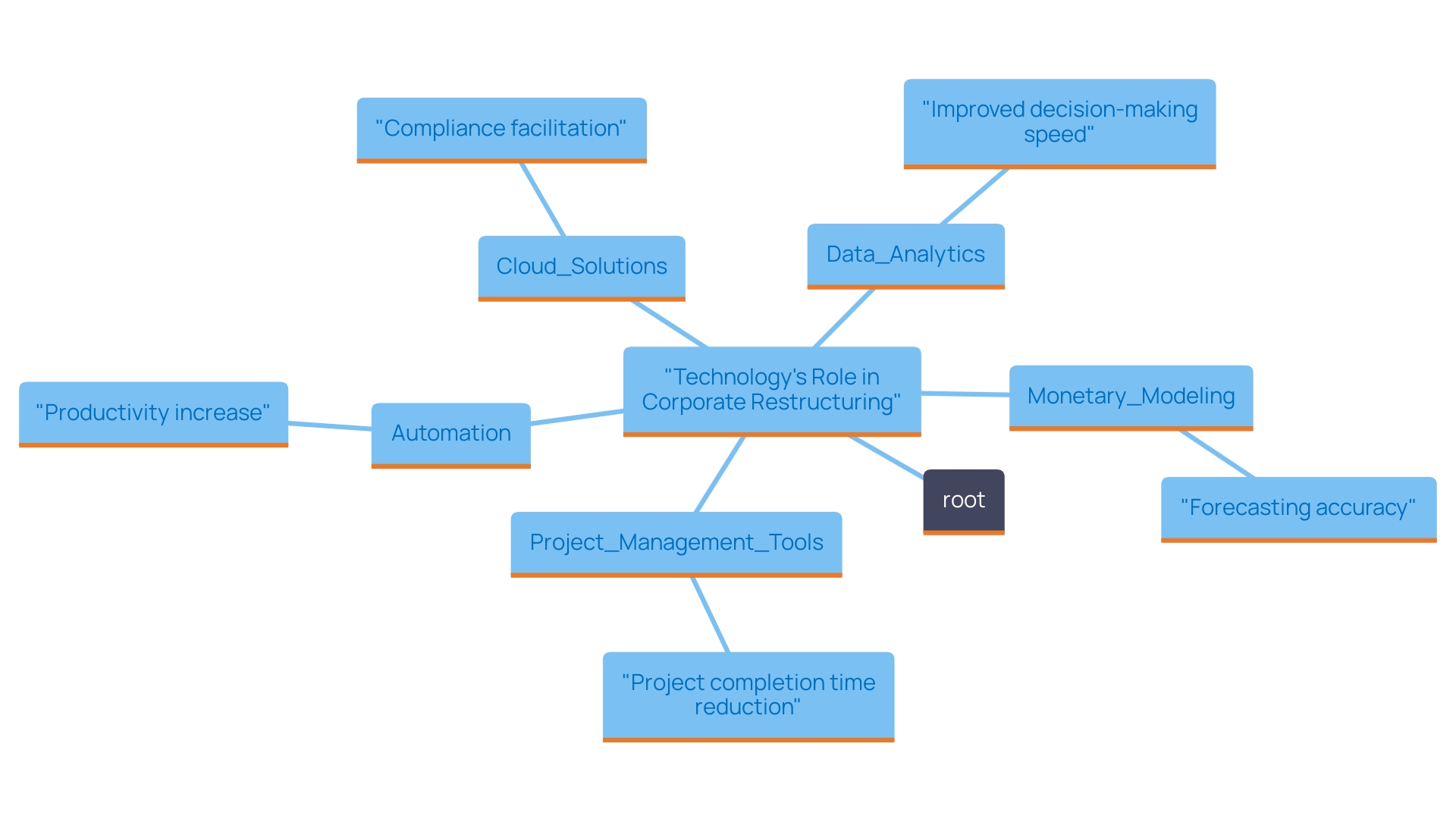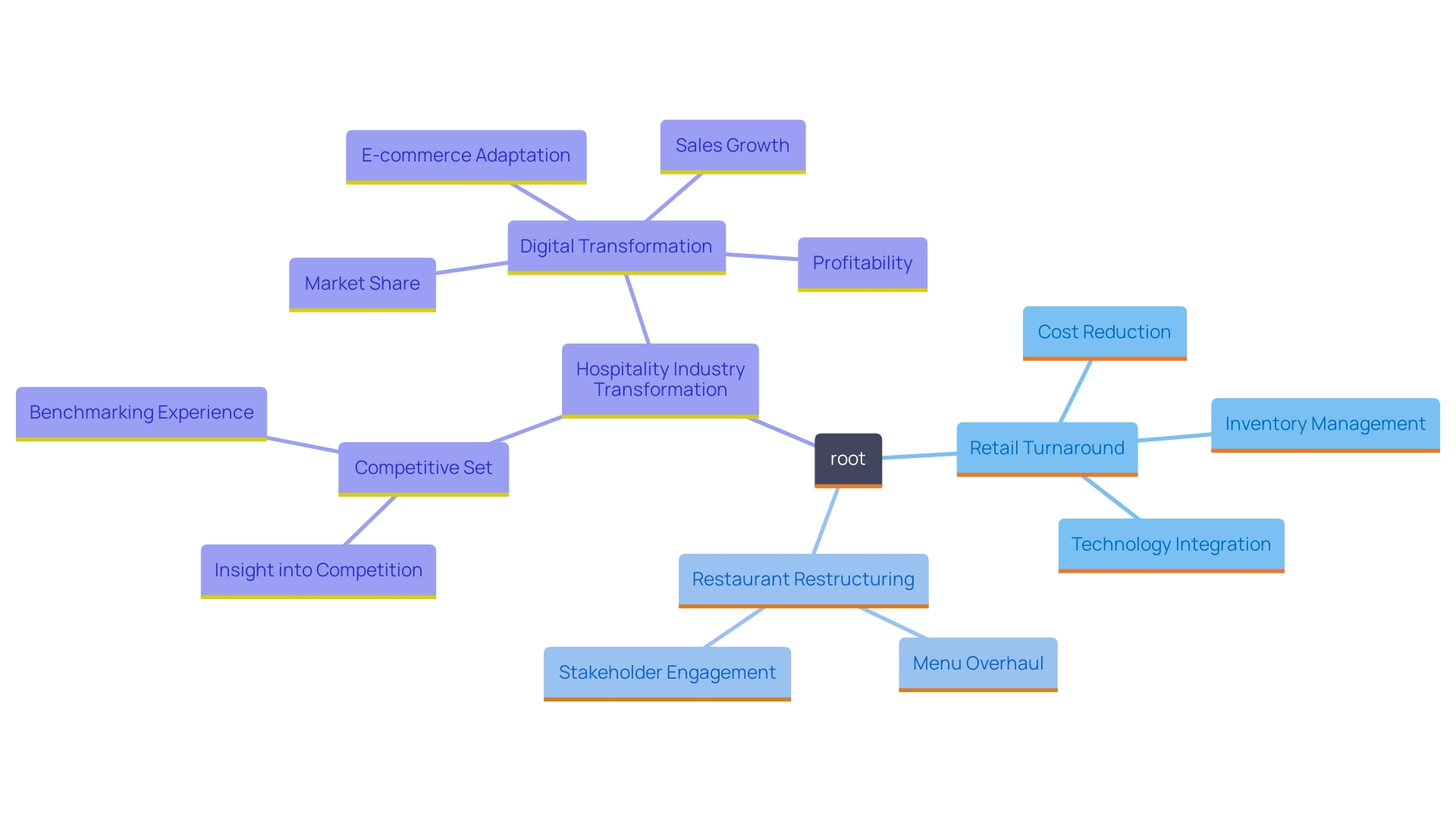Introduction
In the complex realm of corporate finance, the ability to navigate financial challenges and optimize resources is paramount for achieving sustainable growth. As companies grapple with evolving market dynamics, mastering the Cash Conversion Cycle (CCC) emerges as a pivotal strategy for enhancing cash flow and profitability. This article delves into the fundamental principles of corporate finance and restructuring, providing CFOs with actionable insights into capital structure, financial analysis, and risk management.
By exploring effective restructuring strategies and the integration of technology, organizations can not only streamline operations but also position themselves for success in an increasingly competitive landscape. With real-world case studies illuminating successful transformations, this guide equips financial leaders with the tools necessary to drive impactful change and secure a robust financial future.
Fundamentals of Corporate Finance and Restructuring
Corporate finance plays a pivotal role in managing a company’s monetary resources, with a primary focus on maximizing shareholder value through strategic planning and investment initiatives. In today's rapidly changing economic landscape, mastering the Cash Conversion Cycle (CCC) is more critical than ever. It serves as a key lever for enhancing business performance, cash flow, and profitability. The fundamental components of corporate finance include:
-
Capital Structure: A crucial aspect involves balancing debt and equity to optimize the cost of capital. Companies must assess their capital structure regularly, especially in light of recent trends, such as the National Australia Bank Limited's cessation of 238,229 ordinary fully paid securities due to an on-market buy-back. This strategic move not only underscores the importance of optimizing capital structure but also reflects a trend where firms actively manage their equity to enhance shareholder confidence and positively influence market performance.
-
Economic Analysis: Conducting comprehensive assessments of economic statements is essential to evaluate organizational performance and pinpoint areas for enhancement. This practice allows CFOs to make informed choices that promote economic success. Recent statistics suggest that companies employing advanced analytics in economic analysis experience a 15% enhancement in decision-making speed, a considerable edge in today’s fast-paced market.
-
Cash Flow Management: Effective monitoring of cash inflow and outflow is vital for maintaining liquidity and operational efficiency. Strong cash flow management guarantees that companies can fulfill their obligations while investing in growth opportunities. By implementing the strategies outlined in our whitepaper, “Mastering the Cash Conversion Cycle: 20 Strategies for Optimal Business Performance,” organizations can improve their cash flow management practices and are 25% more likely to achieve their strategic goals. For instance, companies that have adopted just-in-time (JIT) inventory systems often report a reduction in inventory days, significantly enhancing their cash flow.
-
Risk Management: Identifying and mitigating monetary risks is paramount. Implementing strategies such as diversification and hedging techniques can protect the organization against market volatility and unexpected economic challenges. A recent survey revealed that 60% of CFOs believe that proactive risk management significantly contributes to overall business resilience.
Restructuring is another critical element that involves reorganizing a company’s framework to enhance economic stability. This can include a variety of strategies, such as operational adjustments, debt modification, and asset sales. An effective reorganization process requires a comprehensive strategy, tackling the distinct challenges that each organization encounters while setting it up for sustainable growth in an ever-changing economic environment.
By mastering the CCC, CFOs not only ensure their organizations have the cash flow needed to reinvest, grow, and thrive, but they also position their companies to adapt swiftly to changing market conditions, ultimately securing a competitive edge in their respective industries.

Strategies for Effective Corporate Restructuring and Financial Advisory
Effective corporate restructuring requires a strategic approach that includes the following steps:
- Conduct a Comprehensive Assessment: Begin with a thorough analysis of monetary statements, operational procedures, and market conditions to identify inefficiencies and areas for improvement. Our team will identify underlying business issues and work collaboratively to create a plan that allows the business to reinvest in key strengths.
-
Example: A retail client identified excessive overhead costs through detailed financial audits, leading to targeted cost-cutting measures.
-
Create a Clear Reorganization Plan: Outline specific objectives, timelines, and responsibilities for the reorganization, ensuring all stakeholders are aligned. We support a shortened decision-making cycle throughout the turnaround to enable decisive action.
-
Example: A hospitality client implemented a phased reorganization plan that streamlined operations and improved service quality, resulting in increased customer satisfaction and revenue.
-
Engage Stakeholders: Involve key stakeholders, including employees, investors, and creditors, in the reorganization process to build support and reduce resistance. Regular updates through our client dashboard provide [real-time business analytics](https://the-cfo.io/2024/07/09/corporate-restructurings-are-on-the-rise-but-why/), continually diagnosing your business health and fostering stakeholder engagement.
-
Example: Regular communication with the workforce during a reorganization initiative kept morale high and fostered a collaborative environment.
-
Implement Change with Precision: Execute the restructuring plan methodically, monitoring progress and making adjustments as needed to stay on track. Our pragmatic approach includes testing every hypothesis to deliver maximum return on invested capital in both the short and long term.
-
Example: A restaurant chain utilized technology to optimize inventory management, leading to significant cost savings and improved profitability.
-
Evaluate and Adapt: After implementing changes, continuously assess the outcomes and be willing to adapt strategies based on performance metrics and changing market conditions. We are committed to developing strong, lasting relationships through our commitment to operationalizing the lessons learned throughout the turnaround process.
- Example: A retail client conducted quarterly reviews to analyze performance after restructuring, allowing for agile adjustments that maintained growth momentum.


Strategies for Effective Corporate Restructuring and Financial Advisory
Effective corporate restructuring requires a strategic approach that includes the following steps:
- Conduct a Comprehensive Assessment: Begin with a thorough analysis of monetary statements, operational procedures, and market conditions to identify inefficiencies and areas for improvement. Our team will identify underlying business issues and work collaboratively to create a plan that allows the business to reinvest in key strengths.
-
Example: A retail client identified excessive overhead costs through detailed financial audits, leading to targeted cost-cutting measures.
-
Create a Clear Reorganization Plan: Outline specific objectives, timelines, and responsibilities for the reorganization, ensuring all stakeholders are aligned. We support a shortened decision-making cycle throughout the turnaround to enable decisive action.
-
Example: A hospitality client implemented a phased reorganization plan that streamlined operations and improved service quality, resulting in increased customer satisfaction and revenue.
-
Engage Stakeholders: Involve key stakeholders, including employees, investors, and creditors, in the reorganization process to build support and reduce resistance. Regular updates through our client dashboard provide [real-time business analytics](https://the-cfo.io/2024/07/09/corporate-restructurings-are-on-the-rise-but-why/), continually diagnosing your business health and fostering stakeholder engagement.
-
Example: Regular communication with the workforce during a reorganization initiative kept morale high and fostered a collaborative environment.
-
Implement Change with Precision: Execute the restructuring plan methodically, monitoring progress and making adjustments as needed to stay on track. Our pragmatic approach includes testing every hypothesis to deliver maximum return on invested capital in both the short and long term.
-
Example: A restaurant chain utilized technology to optimize inventory management, leading to significant cost savings and improved profitability.
-
Evaluate and Adapt: After implementing changes, continuously assess the outcomes and be willing to adapt strategies based on performance metrics and changing market conditions. We are committed to developing strong, lasting relationships through our commitment to operationalizing the lessons learned throughout the turnaround process.
- Example: A retail client conducted quarterly reviews to analyze performance after restructuring, allowing for agile adjustments that maintained growth momentum.


Leveraging Technology in Restructuring Efforts
Technology is fundamental to effective corporate restructuring, providing CFOs with tools and strategies that drive efficiency and informed decision-making. Here are several key strategies to consider:
-
Data Analytics: Utilize advanced analytics tools to gain insights into economic performance, customer behavior, and operational efficiency. Organizations utilizing data analytics have reported a 25% increase in decision-making speed. This data-driven approach empowers CFOs to make strategic decisions backed by solid evidence, while real-time business analytics help continuously assess organizational health.
-
Monetary Modeling: Use monetary modeling software to simulate various restructuring scenarios. This enables stakeholders to visualize potential impacts and outcomes, facilitating a more informed implementation. Recent studies indicate that companies using modeling achieve a 15% higher accuracy in forecasting economic results, which supports cash preservation and risk mitigation.
-
Project Management Tools: Utilize project management platforms to monitor progress, allocate responsibilities, and improve communication among team members during the restructuring phase. These tools help ensure that all efforts are aligned and managed effectively, reducing project completion time by approximately 20% and fostering strong relationships through collaboration.
-
Automation: Adopt automation technology to optimize repetitive tasks, such as financial reporting and compliance checks. By automating these processes, organizations can redirect resources toward more strategic initiatives that drive growth. Research indicates that companies embracing automation see a 30% increase in productivity, enabling continuous monitoring of performance.
-
Cloud Solutions: Embrace cloud-based management systems that promote real-time collaboration, enhance data accessibility, and improve security. Such solutions are increasingly essential in an era of tightening regulatory standards, particularly around online safety and accountability. In 2024, new regulations will require CFOs to implement practices ensuring fairness and transparency, making cloud solutions vital for compliance.
By strategically leveraging these technologies, businesses can streamline their transformation processes while operationalizing lessons learned throughout the turnaround journey. This improves both efficiency and effectiveness in reaching monetary objectives. As the landscape evolves, particularly with new regulations focusing on fairness and transparency, organizations prioritizing these technological advancements will secure a competitive advantage.

Case Studies in Successful Restructuring
Investigating successful reorganization case studies uncovers effective tactics that can be utilized across different industries, especially for CFOs encountering economic challenges. Consider the following examples:
-
Retail Turnaround: A prominent national retail chain confronted significant challenges with declining sales and escalating debt. By executing a comprehensive restructuring initiative that prioritized cost reduction, enhanced inventory management, and improved customer engagement strategies, this company successfully returned to profitability within a mere two years. This case emphasizes the critical role of a focused approach in addressing economic distress, demonstrating that targeted interventions can yield rapid results.
-
Restaurant Restructuring: A regional restaurant group faced severe cash flow constraints driven by rising operational costs. Through meticulous monetary analysis and a strategic overhaul of their menu and pricing framework, they not only improved profit margins but also elevated customer satisfaction. This reorganization, supported by real-time analytics to monitor success continuously, enabled them to expand their market presence, highlighting the importance of responsiveness to operational challenges in the restaurant industry. This case exemplifies how adaptability can turn potential failure into success.
-
Hospitality Industry Transformation: A hotel group that struggled with low occupancy rates adopted a technology-driven marketing strategy, coupled with operational efficiencies. This dual approach resulted in a remarkable 30% increase in bookings and a substantial enhancement in overall profitability. Such an example underscores the effectiveness of leveraging technology and operational insights, along with streamlined decision-making processes, to drive economic recovery. The case points to the necessity of embracing innovation in today’s competitive landscape.
These case studies collectively illustrate the value of customized strategies, active stakeholder engagement, and the integration of technology in achieving successful corporate restructuring outcomes. For CFOs, these insights can serve as a blueprint for navigating their own economic challenges. By learning from these examples, CFOs can implement tailored strategies that address their unique operational hurdles, informed by real-time analytics and the operationalization of lessons learned throughout the turnaround process. Ultimately, the key takeaway is that a strategic focus on adaptability, technology integration, and stakeholder collaboration can significantly enhance financial recovery efforts.

Conclusion
Mastering the intricacies of corporate finance and effective restructuring is essential for CFOs aiming to enhance their organization's financial health and market position. By understanding the fundamental components such as capital structure, financial analysis, cash flow management, and risk management, financial leaders can implement strategies that not only optimize resources but also secure sustainable growth.
The integration of technology plays a crucial role in this process. Advanced data analytics, financial modeling, and automation empower organizations to make informed decisions swiftly, ensuring they remain agile in an ever-evolving market. The case studies explored highlight the transformative potential of tailored restructuring strategies, underscoring the importance of adaptability and stakeholder engagement in achieving successful outcomes.
In conclusion, embracing a comprehensive approach to corporate finance and restructuring is not merely a strategy; it is a necessity for navigating today’s complex financial landscape. By leveraging insights from real-world examples and aligning technological advancements with strategic goals, CFOs can foster resilience and drive their organizations toward a robust financial future. The time to act is now—implement these strategies and position your organization for lasting success.




